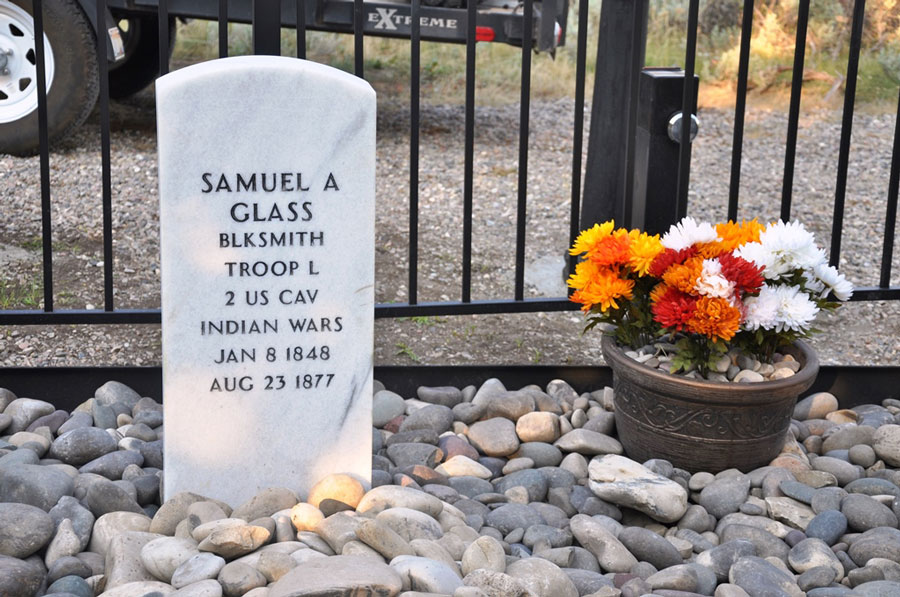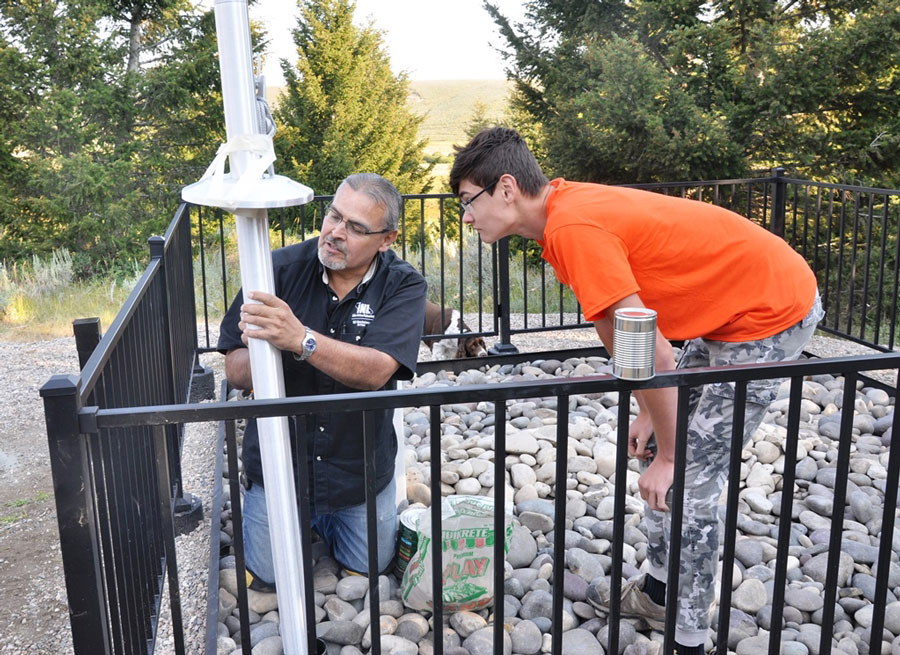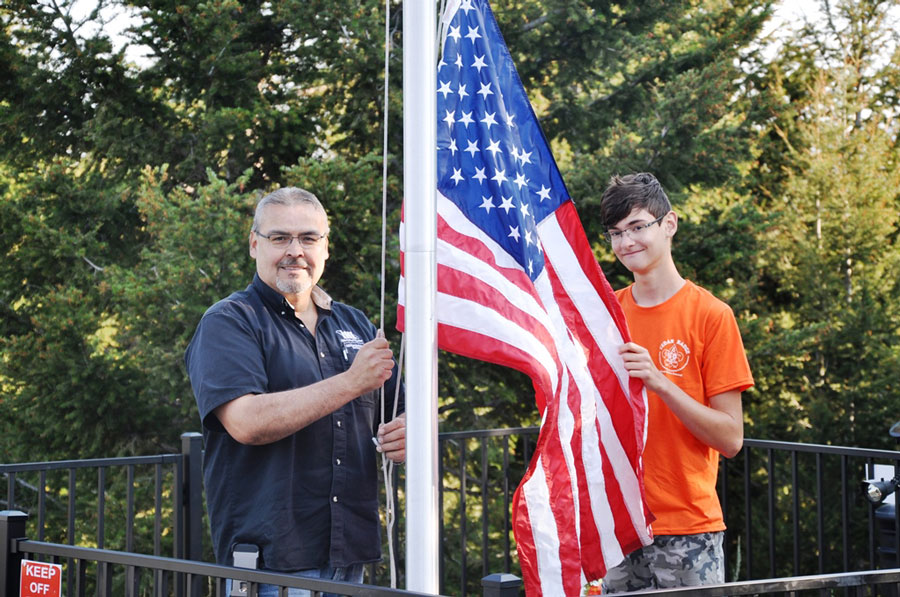Gravesite of U.S. soldier gets facelift 140 years after his death, and now it’s being rededicated
Published at | Updated at
IDAHO FALLS – Just off the Stoddard Creek Exit 184, tucked away in the Pleasant Valley area near Spencer, lies the freshly restored gravesite of an American soldier.
The gravesite bears the name of 2nd U.S. Cavalry Trooper Samuel Glass. If that name is not familiar to you, you’re not alone.
Glass died from wounds he received in a largely forgotten battle involving the U.S. Army and the Nez Perce Indians in 1877.
The gravesite’s appearance today is a far cry from what it used to look like when Idaho Falls native Jay Hill first saw it four years ago. Hill first heard about the gravesite from a book he had read about the Battle of Camas Meadows. Glass was one of three men killed in the battle.
On an ATV ride with his wife in the summer of 2014, Hill set out to try to find the soldier’s grave.
“I didn’t have to look very far to see this old grave. When I got over there, I knew the name right off the bat,” Hill tells EastIdahoNews.com. “I told my wife, ‘This is one of the guys,’ and the dates matched up. The second thought I had was how pathetic that grave was. It was a mess.”
It’s not going to look this way for long if I can help it, Hill thought.

The Battle of Camas Meadows
The Oregon Trail had brought hordes of people to what was then the Oregon Territory in 1846. A treaty between the U.S. government and the Nez Perce tribe resolved a dispute over settlement and land control in 1855.
Under the terms of the treaty, the Nez Perce agreed to give up 7.5 million acres of tribal land while still retaining the right to hunt and fish in their traditional places.
A gold rush within the boundaries of the reservation five years later resulted in another surge of people to the area. The government bypassed the terms of the treaty and instead created another treaty that reduced the size of reservation land by 90 percent. Congress ratified the treaty in 1867, despite overwhelming Nez Perce opposition.
All Nez Perce tribes were now being forcibly moved to the reservation. The Battle at Camas Meadows occurred in August of 1877 and is one in a series of conflicts remembered among the Nez Perce as a “painful and tragic encounter with Manifest Destiny.”
Col. John Gibbon and his band of 183 men fought hard against the Nez Perce resistance, but there were heavy casualties on both sides. Gibbon and a number of his officers were killed or wounded in the conflict. The onslaught of more American troops under the command of Gen. Oliver Howard caused the Nez Perce to withdraw.
Glass was among Howard’s troops sent from Fort Ellis, Montana, to join the pursuit of Chief Joseph’s Nez Perce band.
Glass and Pvt. Fred Munn, according to one historical account, slept under one of the freight wagons one night. When they heard Indians shooting and yelling, they jumped out with guns in hand.
“As Sammy got to his feet, he called, ‘Fred, they got me.’ A bullet struck his belt of cartridges, tearing a hole in his abdomen in which four fingers could be inserted,” Munn said in the account.
Glass died of his wounds three days later at the Pleasant Valley stage stop, a few hundred yards from where he is buried today, while en route to Virginia City, Montana.
“The political arguments (of this battle) don’t need to come up when talking about Samuel Glass,” Hill says. “He was a guy who simply obeyed orders and ended up paying the ultimate price.”
Restoring an American Monument

Hill’s attempt to restore the unkempt gravesite of Samuel Glass also came with a price. He first needed to determine ownership to get the project approved. After more than a year, Hill learned the gravesite is privately owned by a family in Hamer.
“I subsequently learned the government put in a headstone in 1937. (Someone later went up there) with a gun and shot it,” Hill says regarding the reason for the headstone’s appearance.
While speaking with the landowner about the grave, Hill learned Bob Skinner, a retired U.S. Navy captain and Vietnam veteran, had bought a new headstone for the gravesite and was waiting to install it.

“It was just a twist of fate that Jay and I were pursuing the same thing,” Skinner says. “We were going in a little bit different direction, but it all came together.”
Hill and Skinner then decided to work together to restore the gravesite.
It took another three years to get approval to begin the project, but the restoration project officially got underway in mid-June 2018.
What started as a simple plan soon became a complex community effort. Home Depot and other organizations donated money for the project. Sara Jacobson, a doctor of veterinary medicine, along with Rod Bitsoi and his son Austin, church groups and a host of others soon became involved.


The project involved clearing the old fence and plant growth around the gravesite and replacing it with a steel fence, increasing the size of the gravesite from 10 feet by 10 feet to 12 feet by 12 feet, adding more dirt and gravel, and installing a flag pole.
Dirt and gravel was provided by the Clark County Road and Bridge Department. Scout Troop 262 in Blackfoot, along with others, helped with construction.
“There were kids involved in every aspect of this project,” Skinner says. “Not any of them had heard about the history. Few, if any, had ever been associated with the death of a military person. Passing on the message of respecting our veterans and honoring those who died for our freedoms — that was important to me.”
One of those kids, Austin Bitsoi, who helped install the flag pole, will receive his Eagle Scout award for his efforts on this project.
“This project has so much impact to the community. Anyone can go and see for themselves, and if they’ve been up there before, they can see just how much has changed,” Austin says. “Just knowing that I can be a part of changing the community like this is really special.”
Rededicating the gravesite
The $5,000 restoration project was complete by the end of July. A rededication ceremony for the gravesite will be held Sept. 15 at 11 a.m. Anyone is welcome to attend. If you would like to attend the ceremony, take Interstate 15 north until you get to the Stoddard Creek Exit (No. 184). Turn left back under the freeway, where you will see signs directing you to a parking area.
“Our plan is to have a van transport folks back and forth from the parking area to the gravesite because there is no safe parking near the gravesite,” Hill says.
Austin will be presented his Eagle Scout award during the ceremony.
“If there’s one thing I can say without hesitation, (Austin’s) earned this award,” Hill says. “We all made a commitment to do this right. We wanted this site to be a place of honor. This isn’t about us. It’s about that trooper and bringing respect back to his gravesite.”
Hill says the project is not done yet. After the ceremony, he still wants to install signs, a rock engraving providing historical background of Samuel Glass and benches around the gravesite.






